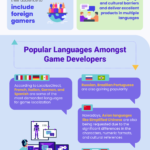Even if the common beliefs could say otherwise, translation is not an easy task to do. And that’s because it’s not just about replacing the words of an original document with the equivalent words in the target language. As translating a text – from websites, advertisements, technical documents, blog posts, or other marketing content to books and games – means communicating the same message and feelings as the source document, what the people usually know about translation could be easily considered more as localization and transcreation. This is very difficult if phrases, when literally translated, become senseless. Therefore, the linguists must use not only the translation and location best practices but also the most important writing tips. This way, they can assure that:
- attract the right audience
- engage the readers (or players, if we are speaking about translating games) in the same way as the original content does.
When making translations, you should consider a few aspects:
- the target audience – Who interacts with your content? Which is their age? How do they speak? What is important for them? Which is their education?
- specific cultural, political, historical, religious, and economic customs and taboos
- the type, style, and genre of the source content
- rules and limitations of the country or region for which you translate
So, for the game’s sake, let’s imagine that you are a linguist and must translate a book from English to another language. How will you approach the situation?
There are two options:
- you consider both versions (the original document and the translation) as being the same content and just replace the words from the source document into the targeted language, making just minor adjustments,
- you consider the translated text as a new type of content and understand that writing plays also a huge role. This way, you can write and convey the messages in the target language and create much more appealing translations that capture the attention of your audiences.
However, writing and translating are part science, part art. But if you want to ensure that you provide the most accurate translation services possible, then pay attention to these 15 essential tips when translating texts, or when looking over a document that will need to be translated.
13 Essential Writing Tips to Ensure Accuracy When Translating
Keep the sentence short
For a simpler translation and increased comprehension, keep your sentences as short as possible. For better readability and understanding, aim to have less than 20 words per sentence, If the original text has a longer phrase, split it into more sentences, without forgetting the meaning of the original text.
Ask yourself: Which is the true message you want to convey? How can you simplify what you want to say? Reading the sentences aloud helps to correct them until they make sense in the new context while keeping them short and sweet.
Understand the story and the characters
Even if it goes without saying, we can’t stop explaining that before starting any translation, make sure you really read and understand the original. Whether you translate a book or a game script, get to know the characters, the plot, and the literary techniques the original writer used. Find out more about the cultural, economic, religious, and political backgrounds of the original document. The more you understand the story and the characters, the better your translation will be.
Maintain the same tone and voice as in the source document
Every writer has her own tone of voice and style of writing. To make a good and real translation of the script, you should convey the same message, feelings, and emotions as the original author, while capturing his personality as best as you can.
Here are a couple of research and writing tips to accomplish this:
- First, study other works of the same writer to get a sense of how he writes. Check the most common words he uses, cadence and style of writing, etc. By immersing yourself in his copy, you’ll better understand the subtle nuances he uses when writing.
- Second, understand the cultural context from which the original text was written. This way, you’ll better inform your translation
Add additional information when necessary
Sometimes what is obvious to one audience may not necessarily be obvious to the other. And this depends strongly on the particularities of the different regions and countries. If you face such a case, then it’s perfectly normal to add extra words or phrases even if they are not present in the original text. This way you’ll clarify the meaning and messages you are trying to convey, helping the readers better understand and immerse themselves in the translated content.
Be careful with humor, idioms, and metaphors
Even if humor, idioms, and metaphors are effective literary techniques used to engage an audience, be careful when you include them in your content. The same goes for jargon and regional phrases because they rarely translate with equivalency. However, in a different cultural context other than the original, these techniques may cause more confusion when you do a direct translation.
However, as useful writing tips when using idioms or metaphors, you might need to replace these sayings with something else which is more familiar to your audience. Alternatively, you can just convey the meaning of your words, rather than trying to find a direct parallel phrase.
For example, for the expression, “I’m feeling under the weather,” you could just translate it to “I’m feeling ill” in another language.
If humor is an important part of your global brand messaging, consider using localization services. This way you communicate the same key message, use the same style and tonality, evoke the same feelings, and achieve the same effect as the source text, but in another language for a particular target audience in a specific market.
Write the translated text like an original content
The goal of the new content is not just to have a translation of the original text, but to engage the audience in your narrative in the same way, if not better than the original one. This means the translation should sound like a real story, not just a translation. Read aloud the new text and make sure everything flows naturally and makes sense.
Be clear with dates and times
Be careful when formatting the date and time in your translated text. Let’s take, for example, 02/09/2029. Is that February or September? Well, depending on the audience you translate for. If you translate for a German audience, then it reads as September, but if you make an English translation and your audience is in the USA, then it reads as February. To avoid any confusion, the safest choice is to spell out the name of the month.
Use the active voice rather than the passive one
One of the most important writing tips is to use the active voice instead of the passive one. It is more direct, easier, and better understood, and engages the audience, especially when combined with second-person singular verbs. Not to mention that it’s also much easier to translate.
Proofread your own work
We can’t stress enough: proofread your own work. And for this stage of your work, you can use several useful tools. Some are free, some are paid but come with a trial period or a basic version which is usually free.
If you translate from another language into English, then Grammarly is a big help. It won’t help you translate, but it is extremely useful for checking your translation.
Another interesting translation app is DeepL, which will help you get a fairly accurate translation in 26 languages.
However, none of the existing apps will translate without any mistake. So, if you are unsure or just consider you need a fresh pair of eyes, ask a friend or a colleague to read your work and make the necessary adjustments. Make sure grammar and punctuation are correct and also polish your content.
This way you prevent errors in translation and limit opportunities for misunderstanding.
Make sure everything fits together
English text is typically shorter than in other languages, which means sufficient space is needed for expansion to other languages – sometimes up to 35%! This is important for software interfaces and graphics.
Some languages use large compound words. So, differences exist not only in sentence length but also in individual word length. Planning ahead saves money and time, especially when it’s about translating games.
Be Clear in Cross-cultural Communication
Mastering this takes some study and practice. But once all the previous steps are accomplished, you can concentrate on the translation process itself. That way, you can pay more attention to further refining the content to suit your audience.
Best advice: for the best quality translation, work closely with your language service partner. Provide all the resources and reference materials your team needs.
Translate what you know
You may not consider yourself an expert, but your experiences and knowledge are valuable to those whose texts you translate.
But that’s only if you tackle fields you know. Because you can’t rely exclusively on machine translations done by AI. No matter how good a translation app is, it still won’t be able to faithfully reproduce a human translation.
Never translate word for word
You should translate the meaning of the sentence or phrase instead of the words. Rely on your experience and knowledge, particularly when the text is difficult. This is one of the best writing tips you can use if you want to engage your audience. Don’t count just on your own translation. It would be of great help to you if can ask a native speaker or a specialist to proofread what you have translated to ensure that it is natural sounding






